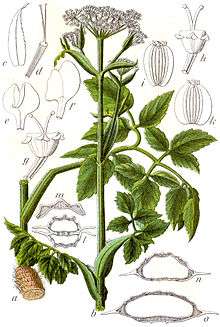Angelica palustris
Angelica palustris (syn. Ostericum palustre), commonly known as marsh angelica, is a biennial or a perennial plant species from the family Apiaceae.
| Angelica palustris | |
|---|---|
 | |
| Scientific classification | |
| Kingdom: | Plantae |
| Clade: | Tracheophytes |
| Clade: | Angiosperms |
| Clade: | Eudicots |
| Clade: | Asterids |
| Order: | Apiales |
| Family: | Apiaceae |
| Genus: | Angelica |
| Species: | A. palustris |
| Binomial name | |
| Angelica palustris | |
| Synonyms | |
| |
It can grow up to 1.2 meter tall. It has bipinnate leaves, meaning arranged opposite each other in rows. The leaves are ovate shaped with scalloped edges. The white combound umbrel flowers bloom from July to August and are five petalled. It has achenes as fruit.[2]
The plant is native to Europe, such as Yugoslavia (Serbia and Montenegro) and central Asia, Siberia.[2]
It prefers to grow in a wide variety of soils, from loamy, sand and clay soils and can tolerate a sunny or half shady position.[2]
The species epithet palustris is Latin for "of the marsh" and indicates its common habitat.[3]
The species was first described and published by Georg Franz Hoffmann in Gen. Pl. Umbell. on page 162 in 1814.[1][4]
Conservation status
This plant occurs in Eastern Europe,[4] and Western Asia, and it is rare and threatened throughout its range. Populations of the plant are generally small and reduced in number, mainly due to habitat loss, and exhibit a marked reduction in genetic diversity. Owing to its Europe-wide conservation status, this plant has been included in the Bern Convention, and subsequently listed in Annex II of the EU Flora–Fauna Directive—Natura 2000.[5]
References
- "Angelica palustris (Besser) Hoffm. is an accepted name". 23 March 2012. theplantlist.org. Retrieved 10 October 2017.
- Boris Lariushin Apiaceae Family: Volume 1, p. 277, at Google Books
- Archibald William Smith A Gardener's Handbook of Plant Names: Their Meanings and Origins, p. 258, at Google Books
- "Apiaceae Angelica palustris Hoffm". ipni.org. Retrieved 10 October 2017.
- Schnittler M, Gunther KF (1999) Central European vascular plants requiring priority conservation measures—an analysis from national Red Lists and distribution maps. Biodiversity and Conservation 8:891–925.